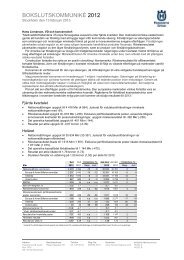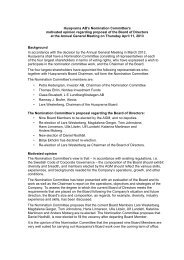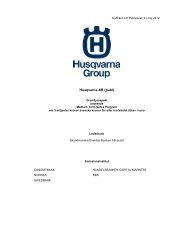Annual Report 2009 - Husqvarna Group
Annual Report 2009 - Husqvarna Group
Annual Report 2009 - Husqvarna Group
You also want an ePaper? Increase the reach of your titles
YUMPU automatically turns print PDFs into web optimized ePapers that Google loves.
Notes <strong>Husqvarna</strong> <strong>Annual</strong> <strong>Report</strong> <strong>2009</strong> 59<br />
Amounts in SEKm unless otherwise stated.<br />
NOTE 2<br />
Financial risk management and financial instruments<br />
Financial instruments are defined in accordance with IAS 32,<br />
Financial Instruments: Presentation and presented in accordance<br />
with IFRS 7 Financial Instruments: Disclosure. Additional<br />
and complementary information disclosing the accounting<br />
and valuation policies adopted is presented in the Note 1,<br />
Accounting and valuation principles.<br />
Financial risk management<br />
Financial risk management for <strong>Husqvarna</strong> entities has been<br />
undertaken in accordance with the <strong>Group</strong> Financial Policy.<br />
Described below are the principles of financial risk management<br />
applicable to <strong>Husqvarna</strong>.<br />
<strong>Husqvarna</strong> is exposed to a number of risks relating to<br />
financial instruments including, for example, liquid funds,<br />
trade receivables, trade payables, borrowings, and derivative<br />
instruments. The primary risks associated with these<br />
instruments are:<br />
• Financing risks in relation to the <strong>Group</strong>’s capital<br />
requirements.<br />
• Interest rate risks on liquid funds and borrowings.<br />
• Foreign exchange risks on export and import flows plus<br />
earnings and net investments in foreign subsidiaries.<br />
• Commodity price risks affecting expenditure on raw<br />
ma terials and components for goods produced.<br />
• Credit risks relating to financial and commercial activities.<br />
The Board of Directors of <strong>Husqvarna</strong> has adopted a <strong>Group</strong><br />
financial policy, as well as a <strong>Group</strong> credit policy, to regulate<br />
the management and control of these risks. These risks are to<br />
be managed according to the limitations stated in the Financial<br />
Policy. The Financial Policy also describes the management<br />
of risks relating to pension fund assets. The purpose of<br />
the policy is to have enough funding available to minimize the<br />
<strong>Group</strong>’s cost of capital and to achieve an effect ive management<br />
of the <strong>Group</strong>’s financial risks.<br />
The management of financial risks has largely been centralized<br />
to <strong>Husqvarna</strong> <strong>Group</strong> Treasury. The measurement and control<br />
of financial risks within <strong>Group</strong> Treasury is performed on a<br />
daily basis by a separate risk control function. Furthermore,<br />
the <strong>Husqvarna</strong> <strong>Group</strong>’s policies include guidelines for managing<br />
operating risk relating to financial instruments, e.g.<br />
through the clear assignment of responsibilities and the allocation<br />
of powers of attorney. Proprietary trading in currencies<br />
and interest-bearing instruments is permitted with tight limits<br />
set within the framework of the Financial Policy. The primary<br />
aims of such trading are to maintain a flow of high quality information<br />
and market knowledge, as well as to contribute to the<br />
proactive management of the <strong>Group</strong>’s financial risks.<br />
Capital structure<br />
<strong>Husqvarna</strong>’s target is for the capital structure of <strong>Husqvarna</strong> to<br />
correspond to a long-term creditworthiness at least equivalent<br />
to BBB rating, according to the principles for credit<br />
assessment of Standard & Poor’s or a similar agency’s. Currently,<br />
this is interpreted to imply that seasonally adjusted net<br />
debt, in proportion to the earnings before interest, tax,<br />
depreciations and amortizations (EBITDA) should not be<br />
higher than 2.5 in the long-term. This target for financial<br />
indebtedness may be adjusted in the event of changes to the<br />
macroeconomic situation, or allowed to deviate for a shorter<br />
period of time due to acquisitions.<br />
<strong>Husqvarna</strong> defines its equity as the sum of share capital,<br />
other reserves and retained profits less minority interests.<br />
Adjusted financial debt, when assessing the capital structure,<br />
is defined as net debt adjusted for pension liabilities. Given<br />
the seasonality of the business, this key ratio varies substantially<br />
during the year. <strong>Husqvarna</strong> has not breached any<br />
external capital requirements during the year.<br />
31 Dec <strong>2009</strong> 31 Dec 2008<br />
Interest-bearing liabilities 9,094 16,287<br />
Less: liquid funds –2,745 –2,735<br />
Net debt 6,349 13,552<br />
Total equity excl. minorities 12,082 8,772<br />
Total assets 30,229 34,337<br />
Net pension liabilities 999 1,034<br />
Adjusted financial debt* 7,348 14,586<br />
EBITDA (12m)* 3,060 3,524<br />
Adjusted financial debt/<br />
EBITDA* 2.40 4.14<br />
Adjusted equity/assets ratio 40.0% 25.5%<br />
* Adjusted financial debt and EBITDA have in the table above not<br />
been adjusted for acquisitions and extraordinary items.<br />
Borrowings and financing risk<br />
Borrowings<br />
The debt financing of <strong>Husqvarna</strong> is managed centrally by<br />
<strong>Group</strong> Treasury in order to ensure efficiency and risk control.<br />
Debt is primarily raised at Parent Company level and transferred<br />
to subsidiaries as internal loans or capital injections. In<br />
this process, various derivatives are used to convert the funds<br />
to the required currency. Financing is also undertaken locally,<br />
mostly in countries in which there are legal restrictions preventing<br />
financing through the Parent Company. The bulk of<br />
the <strong>Group</strong>’s financing is currently conducted through bilateral<br />
loan agreements and through a Swedish Medium Term Note<br />
program. In addition, the <strong>Group</strong> has SEK 10,000m of unutilized<br />
committed revolving credit facilities. The major part of<br />
these facilities matures in 2013. Due to the nature of its business,<br />
the <strong>Group</strong> has major seasonal variations in its funding<br />
needs. These variations have during <strong>2009</strong> been managed primarily<br />
by utilizing the revolving credit facilities, trade receivables<br />
sales programs and to a smaller extent by using the<br />
<strong>Group</strong>’s commercial paper program.<br />
Financing risk<br />
Financing risk refers to the risk that the financing of the<br />
<strong>Group</strong>’s capital requirements and the refinancing of existing<br />
loans could become more difficult or more costly. This risk<br />
can be decreased by ensuring that maturity dates are evenly<br />
distributed over time, and that total short-term borrowings do<br />
not exceed available liquidity. Disregarding seasonal variations,<br />
net debt shall be long-term, according to the Financial<br />
Policy. The <strong>Group</strong>’s goals for long-term borrowings include an<br />
average time to maturity of at least two years, and an even

















